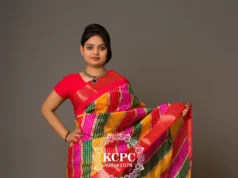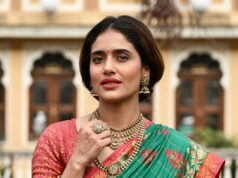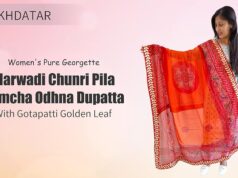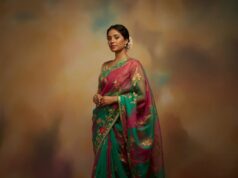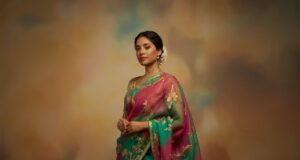The saree is a traditional Indian garment that comes in various styles, each representing the unique cultural heritage of different regions. Among them, the Gujarati saree holds a special place, known for its elegance, vibrant colors, and intricate patterns. In this blog, we’ll explore what makes the Gujarati saree so popular, the different types, and tips on how to style it for various occasions.
What is a Gujarati Saree?
The Gujarati saree, also known as the “Bandhani saree,” originated in the western state of Gujarat. What makes it distinct is its Bandhani tie-dye technique, where small portions of fabric are tied with threads and then dyed in various colors. This process creates beautiful patterns and vibrant color contrasts. The Gujarati saree draping style, also known as the Seedha Pallu, brings out the elegance of the saree by showcasing the pallu (the loose end) prominently in front.
Types of Gujarati Sarees
Gujarati sarees come in several styles, each with its own beauty and traditional significance. Here are a few popular types:
- Bandhani Saree
- Bandhani sarees are iconic and are made using the traditional tie-dye technique. These sarees are often bright and colorful, with patterns that include dots, waves, and small circles.
- Bandhani sarees are iconic and are made using the traditional tie-dye technique. These sarees are often bright and colorful, with patterns that include dots, waves, and small circles.
- Patola Saree
- Patola sarees are handwoven with intricate designs, often showcasing geometric patterns. These sarees are usually made of silk and are highly valued for their craftsmanship.
- Gharchola Saree
- Worn often for weddings, Gharchola sarees are known for their grid patterns, often adorned with zari (gold or silver threads) to add a festive touch.
- Panetar Saree
- The Panetar saree is a traditional bridal saree in Gujarat, usually white or off-white with red borders. It’s adorned with zari and sometimes has Bandhani patterns to symbolize blessings.
Why Gujarati Sarees are Unique
- Craftsmanship: Gujarati sarees are crafted by skilled artisans who use techniques passed down for generations, making each saree unique.
- Color Vibrancy: The bold and contrasting colors in Gujarati sarees are eye-catching, adding a festive appeal suitable for weddings, festivals, and other celebrations.
- Patterns and Designs: Gujarati sarees offer a wide range of patterns, from simple dots to intricate geometric and floral designs, showcasing the creativity of Gujarati artisans.
How to Style a Gujarati Saree
Styling a Gujarati saree can enhance your look while respecting tradition. Here are some tips to bring out the best in your saree:
- The Traditional Draping Style:
- The Seedha Pallu style is the best way to drape a Gujarati saree. It brings the pallu to the front, showcasing the beautiful designs and adding a regal touch.
- Jewelry:
- Pair your saree with traditional jewelry like kundan, polki, or oxidized silver jewelry. These pieces complement the vibrant colors and rich patterns of Gujarati sarees.
- Blouse Design:
- Choose a blouse design that highlights the saree’s patterns. For example, a simple blouse works well with heavily patterned sarees, while embroidered or sequined blouses look good with plain Bandhani sarees.
- Footwear:
- Go for traditional footwear like mojaris or juttis to complete the look. These shoes add an authentic touch and go well with the ethnic appeal of the Gujarati saree.
When to Wear a Gujarati Saree
Gujarati sarees are versatile and suitable for a range of occasions:
- Weddings: Patola and Gharchola sarees are perfect for wedding functions due to their elaborate patterns and rich fabric.
- Festivals: Bandhani sarees are ideal for festivals like Navratri, Diwali, and Raksha Bandhan, where bright colors add to the festive spirit.
- Everyday Wear: Lighter Bandhani sarees can be worn for casual or daily wear, as they are comfortable and easy to style.
Care Tips for Your Gujarati Saree
To keep your saree looking fresh and vibrant for years, follow these care tips:
- Hand Wash or Dry Clean: For delicate fabrics like silk, dry cleaning is recommended. Cotton Bandhani sarees can be hand washed with mild detergent.
- Avoid Direct Sunlight: Direct sunlight can fade the colors, so store your saree in a shaded area.
- Use a Soft Iron: Use a low-heat setting when ironing to avoid damaging the fabric and designs.
Conclusion
A Gujarati saree is more than just a piece of clothing; it’s a piece of history, art, and culture woven into a fabric. Whether you choose a Bandhani, Patola, or Panetar saree, each one tells its own story. Embrace the elegance of a Gujarati saree for your next event, and enjoy the unique beauty it brings to your wardrobe.
Embrace the Rich Heritage of Gujarat with a Beautiful Gujarati Saree!



